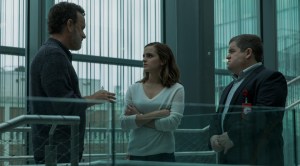The real Apollo 13 mission was largely ignored in 1970. People had already seen men walk on the moon twice before, so this just seemed like more of the same. Interest was so low that lots of news programs weren’t even broadcasting it. Until, that is, things went wrong.
An oxygen tank exploded, which crippled essential systems. The 3 astronauts aboard just had to hang out in an increasingly inhospitable ship as the NASA crew on the ground scrambled to get them home safely. The planned moon walk was of course aborted; they never landed on the moon, just orbited around it. Over the next few days, the spacecraft had limited power, a worrying loss of cabin heat, a shortage or drinkable water, and an urgent need to fix the carbon dioxide removal system or die trying.
America might have been bored with moon walks, but for astronaut Jim Lovell, it would be the culmination of his life’s ambition. It was not to be.
Ron Howard brought this story of NASA’s most successful failure to the big screen in 1995, and still thinks of it as his best film. In fact, he thinks the launch sequence is the highest point of his career, and he’s not wrong. Watching First Man more than 20 years later, it’s clear that Apollo 13 had a huge impact on movies that would follow it.
Jim Lovell thought that perhaps Kevin Costner had a passing likeness, but once Ron Howard signed on as director, he immediately sent the script to Tom Hanks, who is a known space buff. Bill Paxton portrayed Fred Haise, while Kevin Bacon got the role of Jack Swigert, who was never supposed to be there. He was only on the mission as a backup, but blood screening suggested that Ken Mattingly (Gary Sinise) might have the measles, and he was replaced last minute. Though this was an undoubtedly heartbreaking switch, it was Mattingly’s expertise on the ground that ultimately helped save his crewmates. He sat in the simulator for days, doing simulation after simulation until he could work out a way to rescue his friends.

The actors, or actornauts as Howard called them on set, floated around in $30K space suits. And yes, they really did float. Steven Spielberg suggested that Howard approached NASA for special permission to use its KC-135 airplane, and permission was granted. Dubbed the vomit comet, the plane climbs to 38 000 feet and then does a big 15 000 foot drop, creating a zero-gravity effect, but it only creates about 23 seconds of weightlessness. For the film’s production, they had the plane perform 612 dives, for a total of 54 minutes of footage. Even still, sometimes when you see the actors just bobbing around in their capsule, they’re actually just sitting on seesaws. Pretending to be in space is hard! [Note: the 3 actors were very proud to report that none of them vomited on the comet…but several cameramen could not say the same.]
It took them 6 days to get them safely home, and while America did not care about a third module landing on the moon, it became obsessed with the imperiled mission that may or may not return. Millions of people tuned in every night, and so did the friends and families of the astronauts on board. NASA didn’t have time to give them proper updates, so they, like everyone else, relied on Walter Cronkite to feed them information. Ron Howard brought Cronkite in to record a few extra reports.

Tom Hanks and Gary Sinise had of course appeared together the year before in Forrest Gump, where Sinise’s Lieutenant Dan says to Forrest: ” If you’re ever a shrimp boat captain, that’s the day I’m an astronaut.” Lo and behold. The movie is full of little Ron Howard nods: Kathleen Quinlan who plays Jim’s wife Marilyn, actually had her first ever screen credit in American Graffiti, in which she played Peggy, a girl complaining in a bathroom about her boyfriend Steve – who was of course played by Howard himself. He also found a role for Roger Corman, the producer who gave Ron his first big break in Grand Theft Auto. Ron’s mother, his father, his wife, and of course his brother all appear in the film. The real Marilyn Lovell is briefly seen in the grandstands at the launch, and the real Jim shakes hands with the fake Jim aboard the Iwo Jima.
Apollo 13 was well-received, and it holds up well almost 25 years later. There are lots of movies about astronaut heroes, but Apollo 13 sets itself apart by portraying the time when someone’s dream doesn’t come true. It takes a story whose outcome is known (and in fact infamous: “Houston, we have a problem”) and still makes it feel tense and compelling.

 dream come true starts to feel a little…invasive to Mae. There’s no turning off, no going off-grid. Everyone participates in everything all the time! Horray! So the dream is turning out to be a bit much, but with her father (Bill Paxton) suffering from MS, it’s extremely hard to turn down.
dream come true starts to feel a little…invasive to Mae. There’s no turning off, no going off-grid. Everyone participates in everything all the time! Horray! So the dream is turning out to be a bit much, but with her father (Bill Paxton) suffering from MS, it’s extremely hard to turn down.